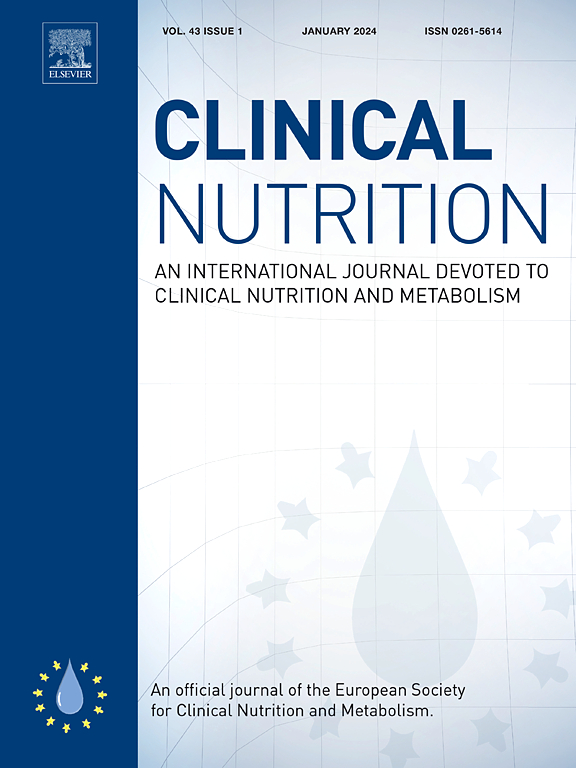Metabolic and hepatic phenotypes in sarcopenic obesity and impact of bariatric surgery
IF 6.6
2区 医学
Q1 NUTRITION & DIETETICS
引用次数: 0
Abstract
Background & aims
Sarcopenic obesity (SO) is associated with cardiometabolic disorders and steatotic liver disease and carries major health risks. We assessed the hepatic and metabolic clinical phenotype associated with SO in patients with obesity undergoing bariatric surgery (BS). We also evaluated whether weight-loss and metabolic improvement post-surgery differ between patients with and without SO.
Methods
972 consecutive patients from a single-center BS cohort who underwent whole-body dual-energy X-ray absorptiometry (DXA) and peri-operative liver biopsy were included. SO was diagnosed using the AIM-SO score, an AI-assisted unbiased clustering algorithm based on body composition. One-year post-surgery, 862 patients were reassessed for AIM-SO score changes.
Results
Pre-operatively, 207 (21.3 %) patients were diagnosed with SO. These patients had significantly higher prevalence of type-2 diabetes (T2D), arterial hypertension and obstructive sleep apnea (OSA) compared to patients without SO (all p ≤ 0.003). Patients with SO had more severe liver damage: higher grades of moderate/advanced steatosis (64.2 % vs. 47.3 %), steatohepatitis (44.4 % vs. 32.3 %) and advanced fibrosis (12.1 % vs. 6.0 %) (all p ≤ 0.01). One-year post-BS, 58.5 % of patients had remission of SO. Patients with persistent SO exhibited less weight-loss than those with SO remission (−23.8 kg vs. −29.1 kg, p < 0.001) and had lower rates of remission for T2D (41.9 % vs. 69.8 %), arterial hypertension (20.8 % vs. 45.3 %), and metabolic syndrome (47.6 % vs. 75.0 %) (all p ≤ 0.009).
Conclusion
The DXA-based AIM-SO score identifies patients with SO who are at greater risk of hepatic and cardiometabolic comorbidities, and predicts less favorable weight-loss and metabolic improvements post-BS.
肌肉松弛性肥胖症的代谢和肝脏表型以及减肥手术的影响。
背景与目的:肌肉松弛性肥胖(Sarcopenic obesity,SO)与心脏代谢紊乱和脂肪性肝病有关,具有重大的健康风险。我们评估了接受减肥手术(BS)的肥胖患者中与 SO 相关的肝脏和代谢临床表型。我们还评估了有 SO 和没有 SO 的患者在术后体重减轻和代谢改善方面是否存在差异。方法:我们纳入了来自单中心减肥手术队列的 972 名连续患者,他们都接受了全身双能 X 光吸收测定(DXA)和围手术期肝脏活检。SO采用AIM-SO评分进行诊断,这是一种基于身体成分的人工智能辅助无偏见聚类算法。术后一年,对862名患者的AIM-SO评分变化进行了重新评估:术前,207 名患者(21.3%)被诊断为 SO。与无 SO 患者相比,这些患者的 2 型糖尿病(T2D)、动脉高血压和阻塞性睡眠呼吸暂停(OSA)发病率明显更高(P 均≤ 0.003)。SO患者的肝损伤更严重:中度/重度脂肪变性(64.2% 对 47.3%)、脂肪性肝炎(44.4% 对 32.3%)和晚期纤维化(12.1% 对 6.0%)的程度更高(所有 p 均小于 0.01)。BS一年后,58.5%的患者SO症状缓解。与SO缓解的患者相比,SO持续存在的患者体重减轻幅度较小(-23.8千克对-29.1千克,P 结论:SO缓解的患者体重减轻幅度较小(-23.8千克对-29.1千克,P):基于 DXA 的 AIM-SO 评分可识别出肝脏和心脏代谢合并症风险较高的 SO 患者,并预测 BBS 后体重减轻和代谢改善的情况。
本文章由计算机程序翻译,如有差异,请以英文原文为准。
求助全文
约1分钟内获得全文
求助全文
来源期刊

Clinical nutrition
医学-营养学
CiteScore
14.10
自引率
6.30%
发文量
356
审稿时长
28 days
期刊介绍:
Clinical Nutrition, the official journal of ESPEN, The European Society for Clinical Nutrition and Metabolism, is an international journal providing essential scientific information on nutritional and metabolic care and the relationship between nutrition and disease both in the setting of basic science and clinical practice. Published bi-monthly, each issue combines original articles and reviews providing an invaluable reference for any specialist concerned with these fields.
 求助内容:
求助内容: 应助结果提醒方式:
应助结果提醒方式:


